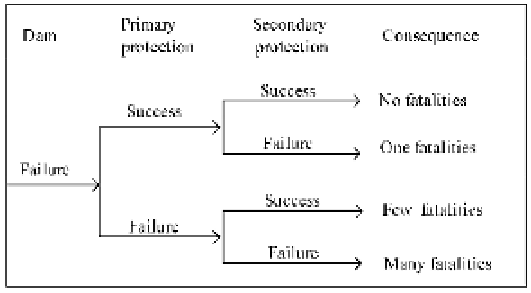Environmental Engineering Reference
In-Depth Information
Significant Hazard
—Dam failure could possibly cause some loss of life and property damage.
Low Hazard
—Dam failure would be unlikely to cause loss of life or property damage.
A dam may be rated as high hazard but have low risk of failure. For instance, the Horsetooth Reservoir
Dams in Colorado are rated as high hazard dams. The use of the term "high hazard" means that should the
dam fail even though this possibility is remote, the failure could cause loss of life to downstream residents.
On the positive side, these dams have a satisfactory rating when it comes to a structural assessment.
Satisfactory is the highest of the three structural assessment ratings. The state of repair assessment has
four ratings: excellent, good, poor, and unacceptable. The Horsetooth Reservoir Dams are rated in the
good category (http://fcgov.com/oem/dam-failure.php). The excellent rating is only given to those dams
which are maintained in essentially new or original condition.
Fell et al. (2000) summarized the methods for the estimation of dam failures for use in quantitative
risk assessment. They recognize the following two broad categories of methods:
Historic Performance Methods
—These methods use the historic performance of dams similar to the
dam being analyzed to assess a historic failure frequency, and assume that the future performance of such
dams will be similar. These methods do not directly account for the reservoir loading, nor do they allow
for the detailed characteristics of the dam or for the particular intervention. Generally speaking, these
methods are only applicable for initial or portfolio risk assessments, and for checking more detailed
event tree methods, and should not be used alone for detailed assessments.
Event Tree Method
—An event tree is a visual representation of all the events which can occur in a
system. As the number of events increases, the picture fans out like the branches of a tree.
Event tree
analysis
provides an inductive approach to reliability assessment as event trees are constructed using
forward logic. Fault trees use a deductive approach as they are constructed by defining events and then use
backward logic to define causes. Event tree analysis and fault tree analysis are, however, closely linked. Fault
trees are often used to quantify system events that are part of event tree sequences (www.isograph-
software.com, 2007).
Event trees can be used to analyze systems in which all components are continuously operating, or
for systems in which some or all of the components are in standby mode—those that involve sequential
operational logic and switching. The starting point (referred to as the initiating event) disrupts normal
system operation. The event tree displays the sequences of events involving success and/or failure of the
system components. A simple example of a dam failure event is shown in Fig. 7.29.
Fig. 7.29
An example of event tree describing the consequences of dam failure
The goal of an event tree is to determine the probability of an event based on the outcomes of each
event in the chronological sequence of events leading up to it. By analyzing all possible outcomes, one
can determine the percentage of outcomes which lead to the desired result. Event tree methods have the


Search WWH ::

Custom Search